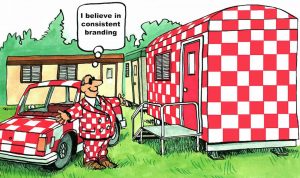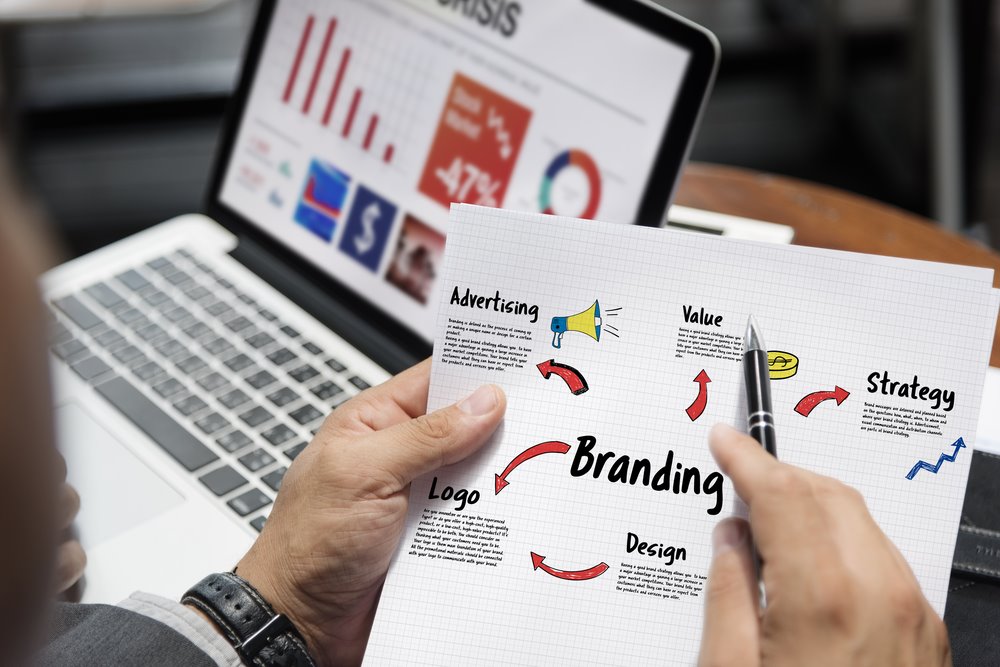 When all that work that you’ve been doing to build your brand to make it a household word finally begins to pay off, something else happens. Your brand becomes vulnerable! When it was new and relatively unknown, you could make a mistake and it would not be noticed by the broader market. But now your brand is out there, and everybody knows who you are. Any slip-ups now in reputation, integrity or value are widely broadcast. We like to say, “You can’t be discontinued from the chain until you first succeed in getting into the chain!”
When all that work that you’ve been doing to build your brand to make it a household word finally begins to pay off, something else happens. Your brand becomes vulnerable! When it was new and relatively unknown, you could make a mistake and it would not be noticed by the broader market. But now your brand is out there, and everybody knows who you are. Any slip-ups now in reputation, integrity or value are widely broadcast. We like to say, “You can’t be discontinued from the chain until you first succeed in getting into the chain!”
In the consumer packaged goods space, your brand is your product. And your product’s distribution is your brand’s equity. When brands are acquired, a big factor in brand value is the size of their distribution (where it’s for sale). Another big factor is the potential for future distribution and sales. Any branding mistakes you make can damage your brand equity and reduce your sales potential.
Even so, every time we go into the marketplace, we see these common branding mistakes:
1. Scaling Too Fast.
We like to say, “Get your act together before you take your show on the road!” Probably the most common branding mistake we see are brands that scaled too fast. They didn’t fully understand the cost of sales – not the cost of goods, but the cost of sales! These costs include but are not limited to all of those activities that guarantee an excellent customer experience, the most important of which is being in stock at retail when your customer comes back to buy your brand.
They tried it. They liked it. And they came back for more. But it was gone! Why? The brand builder believed that it was their brokers’, distributors’, or retailers’ responsibility to keep their brand in stock. The brand builder did not believe they needed a representative in that new territory to quickly replenish out-of-stocks. Or they didn’t expand slowly enough to develop the cash flow necessary to have a budget for that representative. Or sometimes they expanded into too many new territories at the same time – then started having out-of-stock problems which their distribution chain told them were just “slow sales.” And they believed it!
These mistakes happen when the brand builder scales too quickly. They know the cost of goods, but do they really know the cost of sales? You can’t truly know the cost of sales without starting small and making your mistakes in a small place that you can manage. In the process, you will learn what is required to keep your brand in stock.
Even so, many new brand builders who do start small (because they are undercapitalized), discount or fail to fully appreciate their own personal labor in those early days. You may be making deliveries, inspections, or installing signage and display materials. You may be doing a lot of the legwork you can no longer do when you expand into new territories far removed from your base of operations.
Still you expand. Now you find out that the retailers’ supply chain which includes the retailers’ clerks and buyers, their distributors’ salespeople and delivery systems, and your own salespeople, logistics people, and warehousing staff (not to mention production) all have to be kept under constant vigilance. Your brand representatives have to pick up the slack, make up the difference, and guarantee your shelf presents.
Maybe you listened to your VCs who were telling you to “Scale fast and fail fast.” But the problem with scaling too fast is that without vigilance, your branded products can quickly get the reputation of being “slow movers” and “nonstarters.” Chain buyers care little about the reasons your brand didn’t scan. They don’t care if their own people didn’t take it out of the back room and put it on the shelf. They don’t care if the pricing was wrong or the scan numbers were entered incorrectly into the system. And they don’t care if your distributor missed the delivery or delivered the wrong type of product. All they see is what’s on the screen in front of them. And on that screen is only what scanned out the door of their retail outlets. Anything that went wrong, that prevented your product from scanning, is your problem as the brand builder.
In any retail chain, your brand has a certain amount of time to move a certain volume in a certain number of stores. If you don’t, you are discontinued! You are labeled a “slow mover” industrywide. That reputation precedes you and can really put the skids to your expansion plans. The market never forgets “the brand that failed.” Your competitors’ salespeople will be quick to warn your potential new buyers about the failure of your brand in the previous market. Overcoming a false start in the physical retail space is almost impossible.
Brand building is generally seen as a marketing function and not as a sales and merchandising function. The fact is, in retail, you can’t build your brand unless it’s physically there, and stays there! And that requires sales and merchandising.
2. Inconsistent Branding.
Once you have settled on your brand name, logo, and catch phrase, stick to it! Sure, if you start small as we suggest, you will learn what’s wrong and make required adjustments. But one of the other most common branding mistakes we see is brand builders constantly changing their appearance in the marketplace.
 The marketplace is so crowded with other brands vying for your customers’ attention that you don’t have the luxury of making frequent changes in your appearance. It’s hard enough to get your customers’ attention. It’s hard enough to get your customer to remember your name, logo, label, package, and marketing materials. Making changes once you have become somewhat established is a big mistake.
The marketplace is so crowded with other brands vying for your customers’ attention that you don’t have the luxury of making frequent changes in your appearance. It’s hard enough to get your customers’ attention. It’s hard enough to get your customer to remember your name, logo, label, package, and marketing materials. Making changes once you have become somewhat established is a big mistake.
You lose all the momentum you have gained. Now you’re confusing your customer. Now your customer no longer recognizes your product. This hurts your sales and your ability to build your brand.
The marketplace is so noisy that to be heard you must have one consistent message conveyed over and over again. That message must carry through all your marketing materials. Changing the message confuses your customer. A confused customer won’t make the decision to buy your branded products.
We have seen brand builders using different themes, colors, fonts, and images on their marketing materials placed right next to their branded products whose labels have nothing to do with those materials. We have seen catchphrases used on labels that are different than catch phrases used on signage. Again, the retail marketplace is a harsh, competitive environment that does not leave the brand builder many options. At retail it’s better to err on the side of consistency than to lose your customer in an attempt to be creative.
3. Violation of Brand Guidelines.
A variation on inconsistent branding is a violation of brand guidelines. Your brand guidelines are the limits to the narrow focus that your brand addresses. This focus is narrow for a good reason. With too many different messages or too many different offerings, your brand can exceed what we call its “brand width.” Your brand width, just like band width in communications technology, is the capacity your brand can carry and still make a clean, effective, and lasting statement in the marketplace.
When faced with resistance in the marketplace, many new brand builders will give in to their salespeople who say, “If you only had (this or that) product we could make a sale.” Then the line is expanded to satisfy the demands of the particular buyer the salesperson is talking about. Now that buyer buys the new offering but not the original offerings.
As the sales program continues, more buyers request more and different offerings. Again, the brand builder acquiesces and develops more choices until they have a whole range of products. But they have yet to gain traction. Now the brand message is muddied. Buyers are asking, “What is this brand anyway?” The brand no longer focuses on one or two offerings.
Now your salespeople are confused because they are promoting too many different types of products under the same brand. Now your buyers are “cherry picking” your range and asking you to cannibalize certain of your products to gain placement for others.
Ultimately, once the brand is well-established, it may be possible to add new offerings as line extensions. But when it’s new, it’s fragile, and no one has ever heard of it, it’s downright dangerous to exceed your brand width. Keep it simple. Stay within your brand guidelines. Don’t exceed your brand width!
4. Using a Vague Brand Name.
Another mistake we commonly see is vague brand names. Unfortunately, many brand builders choose brand names they and their friends think are cool, but they have nothing to do with the product or some attribute of the product.
The marketplace is so demanding you can’t afford to be cute, mysterious, or avant-garde. You can’t keep your customer guessing about why and how the name you have chosen is so clever. They’re in a hurry and just don’t have the time for it. They’ve already made up their mind about the brands they buy and here you come asking them to buy a new brand with the name from Mars! Don’t do it! Don’t make your customer ask, “What does this have to do with this type of product?”
When brand names exceed three syllables they lose their strength. Most long brand names like Coca-Cola, Budweiser, and Chevrolet, are reduced anyway by the marketplace into one or two syllables, like Coke, Bud, and Chevy. So why not do it for them, right from the beginning? Make it easy for them to say and easy for them to remember.
Ideally, your brand name should be the same as your logo. This will reinforce your brand name in the mind and memory of your customer. And that’s the purpose of your brand name. It’s a tool to help your customer discover, remember, and distinguish your branded product. This job is tough enough as it is without being vague, confusing, or mysterious. Be clear and straightforward. Be simple, strong, and meaningful. You will reap the rewards with repeat buys and loyal customers.
5. Wrong Target Audience.
What is a target audience? Simply, it is your ideal customer. It is the people for whom you have created your product and who will benefit from it the most. It is the people who will readily recognize the solution your brand is offering for the problem they are facing.
This, of course, raises many questions not the least of which include: What is their problem? What is their age? What is their gender? What is their income? Where do they hang out? What do they already buy? And how can you get your brand in front of them?
Trying to sell to the wrong target audience is a common branding mistake. Typically, brand builders throw too wide a net hoping that within that wide audience there will be some customers who will appreciate their offerings. The problem with this funnel approach is inefficiency, wasted energy, and inability to gain traction quickly. New brand builders must gain traction quickly in order to stay in the stores.
Your brand will be sold within categories and within price points that your retailers have already determined have specific target markets. The question is, are you in the right store? And even if you’re in the right broad market, chain, or box store, are you in the right neighborhood to address your true target market? Solving this problem is critical to gaining early traction.
6. Poor Public Relations.
 O.K. You’ve done everything right. You haven’t made any of the obvious branding mistakes we’ve identified so far. But then the negative news breaks that can stop your sales and hurt your brand. You’ve had a recall, got involved in a lawsuit, labor dispute, or environmental debacle.
O.K. You’ve done everything right. You haven’t made any of the obvious branding mistakes we’ve identified so far. But then the negative news breaks that can stop your sales and hurt your brand. You’ve had a recall, got involved in a lawsuit, labor dispute, or environmental debacle.
People vote with their brand choices. They don’t want their money to go to a company that is not in alignment with their social thinking. They don’t want to feel like they’re supporting business practices that hurt people, hurt their health, or hurt the environment.
How you handle these challenges can make or break your brand. The best approach is to try to avoid these issues altogether by taking into consideration how your behavior as a company reflects on your brand and your brand’s reputation in the marketplace.
When bad news breaks it’s more important how you handle it than the news itself. People will judge you more by the actions you take when you are under duress than when everything is moving along smoothly. Coverups and finger-pointing only exacerbate the negative effect on your brand. Taking responsibility and taking action are the only ways your customers will remain loyal to your brand.
They want to say, “Sure they had a problem but look how they handled it!” After all, it’s their brand and they want to be proud of it.
Bad news can be an opportunity to jujitsu a bad situation with right action and demonstrate to your customers and the general public that you are sensitive and responsive to the issues they think are important.
7. Rebranding.
This is a mistake we see time and again. The reasons for this mistake are many but generally include:
- Thinking the brand name and logo, catchphrase, or packaging are the reasons for a lack of traction in the marketplace, when the real reason may be poor merchandising, poor distribution management, or poor target marketing. These brand builders have the top-down approach. They believe that success or failure is based on graphic designs and not necessarily execution. So, for them, simply changing graphic designs is the “solution.”
- Believing “it’s time for a change” just because a certain amount of time has passed with the old design. They think new is always better. Sometimes they hire a new marketing director who has to make their mark by changing the label so they can take a bow for the sales they’re sure were a result of that change. They’ll likely be gone in two years anyway, so if they had a negative effect, they won’t be around to take responsibility.
- Calculating that they will make more by repositioning the brand to a higher price point. Even if they take a hit on volume, they convince themselves they will make it up at the higher price. They don’t take into consideration the years the brand has established itself in the marketplace at the lower price and that it will carry that low price “stigma” with it and hurt sales at the higher price.
For many reasons, rebranding can be a big mistake. It is very dangerous! That’s why we believe in evolution, not revolution. Have in mind the new brand image you want. Be sober about market forces and the power of merchandising. If you do decide on rebranding, make subtle changes gradually over time. Don’t shock or confuse your customers. Give them a chance to digest every progressive iteration on the road to your final rebranding.
These common branding mistakes and others occur when brand builders underestimate what is really involved in getting their branded product from their warehouse to their consumer. They must understand and respect the distribution system, the retail environment, their customers’ short attention span, and how they can be easily confused. Don’t be the brand builder that says, “Ouch!”


